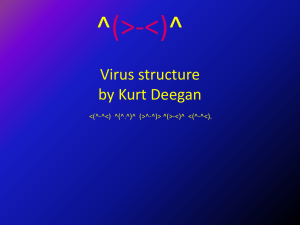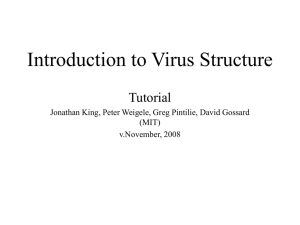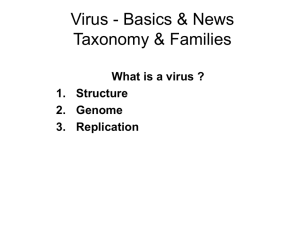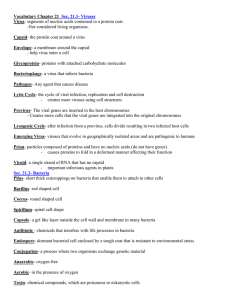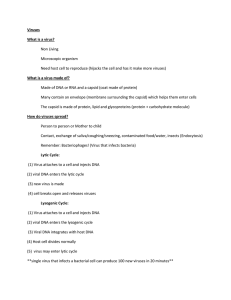Design and Manufacture of a Physical Model of an Icosahedral...
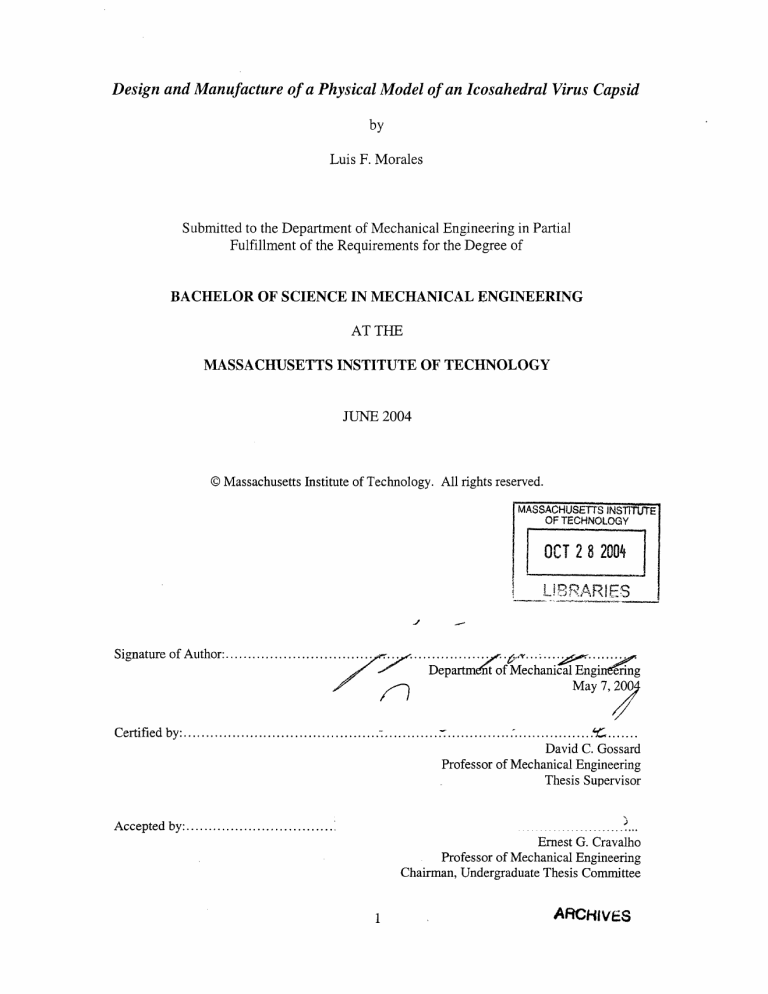
Design and Manufacture of a Physical Model of an Icosahedral Virus Capsid
by
Luis F. Morales
Submitted to the Department of Mechanical Engineering in Partial
Fulfillment of the Requirements for the Degree of
BACHELOR OF SCIENCE IN MECHANICAL ENGINEERING
AT THE
MASSACHUSETTS INSTITUTE OF TECHNOLOGY
JUNE 2004
© Massachusetts Institute of Technology. All rights reserved.
I
____
OF TECHNOLOGY frlT
J M i,
FIUV
3RARIES
I nh
I
Signature of Author: ........................
r'-
................. ........ .. ........
May 7, 200
Accepted by:.................................
1
David C. Gossard
Professor of Mechanical Engineering
Thesis Supervisor
I
Ernest G. Cravalho
Professor of Mechanical Engineering
Chairman, Undergraduate Thesis Committee
ARCHIVES
Design and Manufacture of a Physical Model of an Icosahedral Virus Capsid
by
Luis F. Morales
Submitted to the Department of Mechanical Engineering on May 7, 2004 in Partial Fulfillment of the
Requirements for the Degree of Bachelor of Science in
Mechanical Engineering
ABSTRACT
Viruses enclose genetic material, DNA or RNA, that are the cause of several diseases and conditions suffered by humans such as Influenza, Chickenpox, Smallpox,
Herpes, and Hepatitis C. It is for this reason that viruses are of interest to us. By studying the virus, we can develop methods to counteract their effects as well as advance the knowledge of biology. Motivated by the study of viruses, this thesis consists of the development of a model of a virus capsid for educational and illustrative purposes. This thesis begins with a study of the virus and its capsid structure. It studies the icosahedral structure and the theory of quasi-equivalence, which were favored by viruses throughout their evolution.
We then look into the manufacturing of the model capsid which was composed of three major components; developing the protein subunits that create the capsid, giving the subunits an appropriate mating angle, and joining the subunits to form the virus model.
The subunits were created by two different approaches, through the use delrin, and through injection molding. The angling of the subunits was approached through a fixture designed for this application and a wedge. Finally, the joining and assembly was achieved by using glue. The results had limited success, but it served as an initial prototype and a learning process and established some bases and groundwork for further developments.
Thesis Supervisor: David C. Gossard
Title: Professor of Mechanical Engineering
2
Table of Content
Acknowledgements..................................................................................4
1.0 Introduction .......................................................................................
5
2.0 Theory .............................................................................................
2.1 History ....................................................................................
2.2 Quasi-equivalence and Icosahedral symmetry ......................................
2.3 Geometry and Mathematics of the Icosahedral Symetry ..........................
3.0 Manufacturing Processes .....................................................................
3.1 Angling Fixture ........................................................................
3.2 Preparation of protein subunit parts ................................................
3.2.1 Delrin Approach ............................................................
3.2.2 Injection Molding Approach ..............................................
3.3 Final Assembly ........................................................................
4.0 Results and Discussion ........................................................................
10
11
12
13
14
16
16
5
6
6
9
5.0 Conclusions and Recommendations .........................................................
References...........................................................................................19
17
3
Acknowledgements
First, I would like to acknowledge and thank Professor David C. Gossard whose research this thesis is based on. Thanks to Professor Gossard for allowing me to be a part of this study and development process, for providing valuable counseling and for being a great mentor in general. I would also like to thank Professor Ernest G. Cravalho and
Professor Ernesto E. Blanco who have also been great mentors throughout my time at
MIT and have always supported me.
In addition to the aforementioned professors, I would like to thank the staff at the
Laboratory for Manufacturing and Productivity in particular Patrick McAtamney, David
Dow, Mark Belanger, and Gerald Wentworth who helped me manufacture the thesis hardware. On the same note I'd like to thank the Pappalardo Laboratories staff Dr.
Richard "Dick" Fenner, Steve Haberek, Bob Nuttall, Bob Gertsen, and Joe Cronin and
Mr. Pierce Hayward in the mechanics and materials lab all who helped me in this work in one way or another.
Last but not least, I'd like to thank my family Marisol Benitez, Epifanio Morales,
Jose Morales, and Jorge Morales who have supported me all my life and my friend
Leonardo Marmorato with whom I worked my way through my hardest days at MIT.
4
1.0 Introduction
A virus is an ultramicroscopic infectious agent that replicates itself only within cells of living hosts, and is often pathogenic. Viruses enclose genetic material, DNA or
RNA, in a capsid and are the cause of several diseases and conditions suffered by humans such as Influenza, Chickenpox, Smallpox, Herpes, and Hepatitis C.
A virus will enter a human through openings such as the nose and mouth or through bodily fluids and attaches to particular cells inside the body. The virus will then introduce its own genetic material, DNA or RNA, into the cell. This cell will then go through the lysogenic cycle. It will replicate the viral genetic material along with its own creating more viruses until it becomes saturated and bursts. The created viruses will then spread and repeat the process with other cells causing malfunctions in the body.
Although viruses have the capability of creating serious malfunctions in the human body, they are subject to some constraints. The two major constraints of interest are that the virus cannot survive or reproduce without a host and their small size limits the genetic material they are able to carry in its capsid. During reproduction, the viral genetic material needs to be able to establish instructions to replicate its capsid to house its newly produced DNA or RNA. However, because the viral capsid is so small, the virus has very limited genetic material to begin with and must create a simple capsid with as few proteins as possible retaining its capability to recognize the appropriate host cell and appropriately protect the virus's genetic material. Fortunately, for the virus, the agent has a short "life-cycle" and thus through iteration of this "life-cycle" it evolves very rapidly. Through time, viruses have managed to optimize the construction of its capsid to maximize the space available for genetic material while minimizing the variety of proteins it needs to create it.
The following thesis discusses the development of a model of a virus capsid intended for educational purposes. The model illustrates the salient geometric features and concepts that have been favored by evolution in order to produce the optimal capsid for the virus.
2.0 Theory
A virus's amount of genetic material, and thus the complexity of what it can do, is constrained to a limited amount of space within its capsid. Furthermore, it should be simple to replicate such that not much information is required to reproduce and thus most of its genetic material is focused on other aspects of its operation such as host recognition and genomic material delivery. This chapter will briefly outline the history of studies on virus structure, and will distill the findings and current knowledge on the structure of the virus.
1 dictionary.com
5
2.1 History
In 1953 Crick and Watson proposed the principles that the limited volume of the viron capsid allowed sufficient nucleic acid to code for only a few sorts of proteins of limited size.
2
They concluded that the viron capsid consisted of identical subunits in identical environments, and further studies into this concept proved that only icosahedral and dodecahedral polyhedra allowed for this condition.
3
Later studies by Klug in the
50's and 60's using negative staining and electron microscopy confirmed that spherical viruses had icosahedral symmetry and thus concluded that the icosahedral symmetry was preferred in virus structure.
4
2.2 Quasi-equivalence and Icosahedral Symmetry
Forced to evolve, spherical viruses adopted an icosahedral symmetry. The icosahedral symmetry forms a polyhedron known as an icosahedron, which is characterized by having 12 vertices containing 5-fold symetry, 20 faces containing 3-fold symetry, and 30 edges containing 2-fold symetry. The icosahedron is shown below in figures 1 and 2.
5 3fiod a.i
J' N', .... a
?, , '
Figure 1: Projection of an icosahedron taken from Prof Gossard's
Viruses: 7.88J The Protein Folding Problem.
Figure 2: Paper-folding representation of an icosahedron.
As mentioned previously, the icosahedron is the preferred geometry for spherical viruses, each triangular face representing a protein for which the virus capsid would consist of twenty proteins. However, a need to evolve presses viruses to further increase the volume their capsid can contain. An easy way of achieving this goal is to increase the size of each protein. However, it has been noted that to the increasing the number of proteins or subunits of the virus capsid is significantly more effective than increasing the size of individual proteins. This concept is addressed by Caspar and Klug's theory of
2
Gossard, D. Viruses: 7.88J The Protein Folding Problem. November 12, 2003. slide 11.
3 Gossard, D. Viruses: 7.88J The Protein Folding Problem. November 12, 2003. slide 11.
4 Gossard, D. Viruses: 7.88J The Protein Folding Problem. November 12, 2003. slide 12.
6
quasi-equivalence, which classifies icosahedral shells whose protein subunits all have in the virus shell.
5
This is achieved within the icosahedral symmetry by packing protein subunits such that more than one subunit constitutes one of the twenty faces of the icosahedron. The further extensions of the icosahedral structure are classified by their T number, which is the number of proteins per corner of each triangular face.
6 6
This takes the T1 packing configuration in which each of the icosahedron's triangular faces consists of three proteins and thus has one protein per corner as shown in figure 3 below.
Figure 3:Representation of the subunits in which each face of the icosahedral structure divides under the
Ti packing configuration each constituting a corner of the face. All subunits are of identical geometry and thus only one angle is shown in each.
The T numbers of the icosahedral structure follow the relationship,
T= f2(h2 +hk+k2), (1) where h, k, f = 1,2,3.... The T numbers subsequently follow the series,
1,3,4,7,9,12,13,16,19,21,25.... Additionally, the T number is related to the number of proteins in the icosahedron by the equation,
n = 60T, where n is the number of proteins per icosahedron. Examples of a few T packing
(2) configurations are shown in figure 4 below.
5 Berger, Bonnie; Shor, Peter; Trucker-Kellogg, Lisa; King Jonathan. A Local Rule Based Theory of Virus
Shell Assembly. Mathematics Department and Laboratory for Computer Science and Biology Department,
Massachusetts Institute of Technology, Cambridge, MA 02139; and AT&T Bell Laboratories, Murray Hill,
NJ 07974. p. 3.
6 Berger, Bonnie; Shor, Peter; Trucker-Kellogg, Lisa; King Jonathan. A Local Rule Based Theory of Virus
Shell Assembly. Mathematics Department and Laboratory for Computer Science and Biology Department,
Massachusetts Institute of Technology, Cambridge, MA 02139; and AT&T Bell Laboratories, Murray Hill,
5
NJ 07974. p. .
7
k/
, /
/\ I
\z
I -
I .-
V-J,
T=3
(h,k = 1 1)
T=4
(h.k = 2, 0) n = 240
T=7
(h4k =2,1) n=420
Figure 4: Examples of T packing arrangements.
Protein Folding Problem.
Images taken from Gossard, D. Viruses. 7.88J The
November 12, 2003. slide 16.
Increasing the T packing number in a virus of a virus as shown in figure 5.
capsid will significantly increase the volume
Figure 5: The increase from a Ti packing configuration to T4 packing will manifest in an 8-fold increase in volume. Images taken from Gossard, D. Viruses: 7.88J The Protein Folding Problem. November 12,
2003. slide 17.
The icosahedral structure has been noted as a very effective space maximizing structure while retaining simplicity. It has been applied in several applications such as the ones shown in figure 6 below.
8
l-f <~~i
V"
- T- "
F
-
,
.\
.:
Figure 6: Geodesic Domes and the construct of sports balls are some examples of applied icosahedra in different levels of Tpacking. Images taken from Gossard, D. Viruses: 7.88J The Protein Folding Problem.
November 12, 2003. slide 19.
2.3 Geometry and Mathematics of the Icosahedral Symmetry
The icosahedral structure has been discussed in detail in the previous sections of this chapter. However, it is important to look at the interaction between the proteins and the faces of the icosahedron. The geometry, size, and mating angles required between protein subunits and icosahedral faces will be discussed in this section.
Prior analysis on spherical geometry and regular polyhedra by Prof. Gossard, have been used to determine parameters such as the area and enclosed volume of the icosahedron in relation to the length of the edges of its 20 faces. Other parameters such as the length of the edges of faces themselves and the radius of the sphere circumscribed around the icosahedron are related to one another such that either can be fixed to obtain the other. These two are related by the equation a
4
4
10 + 2-5
R, (3) where a is the length of one of the icosahedron's faces and R is the radius of the circumscribed sphere. The length a can also be expressed as a great-circle-angle through the equation
a= 2sin-/R2j
(4) where a is the great-circle-angle.
7
Using the established or obtained value a, the radius of the inscribed sphere can be obtained by r =-a V42 + 18 .
(5)
12Gossard December 5 2001. p 2.
7 Gossard, D..A Quantitative Look at Quasi-equivalence. December 5, 2001. p 2.
9
Furthermore, the volume and area of the icosahedron can be obtained by the equations
V/ 80(3 + 5) R
+ 2,5)2
3
, and (6)
A = a.
4
(7)
For construction purposes, we are also interested in the angles at which the faces of the icosahedron mate. First is the great-circle-angle formed between the vertex and the face centroid. This angle, defined as 8, can be obtained by the equation,
,g = cos1 (rR)= 37.4°. 9 (8)
The other relevant angle is the angle between adjacent faces of the icosahedron. This angle, defined as y, can be obtained by the equation, r = 2tan1 2 =41.8.10 (9)
3.0 Manufacturing Processes
With the previously explained knowledge of viruses, the focus of this thesis was to manufacture an enlarged model of a virus capsid. This model was constructed to potentially serve as a teaching aid by showing the salient features of the viral capsid.
The materials used in the construction of the virus capsid were delrin and plastic due to their lightweight and cost. The two materials were used to produce subunits of the protein capsid, and thus one of the necessary manufacturing processes consisted of angling the edges of the virus such that adjacent subunits would properly mate to one another. The two main processes in this thesis consisted of developing the protein subunits and developing a method to cut the appropriate angle on the individual subunits of the capsid. The total materials used throughout the thesis were the following:
* 6061 Aluminum 4x1.25x13 inches rectangular bar
* 6061 Aluminum box extrusion lxl, 1/8 inch wall thickness
* Delrin block 1 lx7.75x2
* (Qty.) 8x32, 2 bolts and corresponding nuts
* Instant Krazy Glue® Advanced Formula
* Aluminum Male and Female Molds
* Plastic
The development of the protein subunits and the method of angling the edges of the parts will be discussed in detail in the following subsections.
8
Gossard, D. A Quantitative Look at Quasi-equivalence. December 5, 2001. p 1.
9 Gossard, D. A Quantitative Look at Quasi-equivalence. December 5, 2001. p 2.
'0
Gossard, D. A Quantitative Look at Quasi-equivalence. December 5, 2001. p 2.
10
3.1 Angling Fixture
Several methods were used to attempt to angle the protein subunits. The more involved method consisted of constructing a fixture that was capable of angling the protein subunits in order to cut the required angles using a 3-axis mill. The fixture consisted of a holder with angled edges such that the vise on a mill could grip the fixture on opposing faces setting it at an angle. The fixture was also constructed such that protein subunits could be loaded onto it such that the subunits would be exposed to the mill at an angle. The fixture was designed to hold model protein subunits at an 18.7degree angle, which is half of the beta angle presented in the theory section. This angle is to be used on all faces of a T1 packing configuration to generate a 37.4-degree angle at the edges. The fixture was designed using the Mastercam 9.1 software as shown below in figure 7.
in
Figure 7: Mastercam 9.1 generated schematic of the fixture. The protein subunits are to be loaded on the top one-inch face of the fixture. The sides of the fixture are angled at 18.7 degrees such that a vise could grip the top right and bottom left face to rotate the fixture toward the right, or the top left and bottom right faces to rotate it toward the left.
The fixture was constructed out of a 4x1.25x13 inches rectangular 6061 aluminum bar.
Once again, the Mastercam 9.1 software was used to obtain a script that would allow the geometry to be machined using a waterjet. The resulting parts are shown in figure 8.
Finally, holes were drilled and taped at the top of each fixture part as shown in figure 9 in order to be able to load and machine the subunits.
11
;:,
~;~'
'.;'......'.*' .
.
, ;.........
~ ~ *?*~ .~! :: '
.
,.?:.../ ... ' f
Figure 8: Waterjetedfixtures machined.
Figure 9: Picture of the taped holes used to hold parts.
Several copies of the same fixture were produced in order to join them into one fixture set and accelerate the parts milling process. To accomplish this, lxlxl, pieces of
6061 aluminum box extrusion with 1/8-inch wall thickness were cut and drilled along with the fixture parts. The box extrusion was bolted between adjacent fixture parts in order to provide spacing between adjacent subunits while they were being milled. The completed fixture assembly is shown below in figure 10.
Figure 10: Full assembly of the fixture parts with their spacers. Further work on the fixtures was performed during this thesis, which accounts for the differences in size.
3.2 Preparation of protein subunit parts
The most critical portion of the thesis was to produce the parts that were to model protein subunits. The preparation of the parts consisted of two prototypes. One was done through machining of a delrin block and the other was done by injection molding. First, the geometry of the part was determined using the theoretical data presented in the theory chapter and a Mastercam design was produced as shown in figure 11.
12
0 25 rn
2 7
Figure 11: Dimensioned schematic of the intended protein subunits. All of the sizes and angles were obtained using the information presented in the theory section. n addition to the geometry displayed, the pieces were also equipped with clearance holes for a #8 bolt in order to attach them to the fixture to angle their edges.
3.2.1 Delrin Approach
In order to produce the capsid model, a preliminary prototype was developed using delrin processed through machining. This was intended to observe the manufacturing complications and fix them before going into more involved processes such as the development of a mold for injection molding.
Once the parts were dimensioned as shown in figure 11 above, initial rough cuts were drawn and cut from the delrin block as shown in figures 12 and 13 below.
I
I
Figure 12: dimensioned rough cuts on the delrin block. The subunits were staggered to maximize delrin. Nine of these parts were obtained from the block and drilled to adjust to the fixture.
The parts were then drilled to fit a #8 bolt mated with tapped holes in the fixture to attach them to it for machining of the part profile and mating angle. Once the holes were completed, the parts were sliced into quarter-inch thick pieces to be loaded on to the fixture and the CNC mill.
13
At this point, however, the process complicated. Slicing the parts into quarterinch pieces resulted to be a challenge when it came to maintaining a cutting tool such as the band saw aligned. Different types of band saws were used in an attempt to cut the delrin, but they consistently followed the grain of the delrin. The delrin parts had to be cut very slowly in order to obtained a decent result and thus the process became inefficient. Some of the complications in this cutting process are shown in figure 14 below.
Fi the second and third pictures from left to right. The second picture in turn shows how the saw did not make it past the bottom left corner and instead exited off the face, and the rightmost picture shows the crooked profile of the cut.
3.2.1 Injection Molding Approach
The second approach was producing the parts through injection molding. For this, it was necessary to create a set of molds using the Mastercam software. The dimensioned molds are shown in figure 15 and 16, the molds themselves are shown in figure 17, and the resulting parts are shown in figure 18 below.
8 1 7 1 6
I
5 , 4
· I
3 i,
I 2
I~~~~~~~~-
1
#6 TAPERED
REAMED
D
C C
4-
B B
A
4
|CWmny: A .I.T.
Ti l: FEMALE
A A mensions on 255
_
8 1 7
I I
L
6 1 5 t
I , I
4 1 3 1 2
I I I
I
Figure 15: Fully dimensioned female mold or cavity obtained using Mastercam 9.1.
14
D
I 7 I 6 1 5 4 1 3 I
2
I
0
C
3
E
4 .0000
I oooo
1_
*
A A
D s
Di c level 50., bdr n 255. -. By
___ I w.
8 1 7 1 6 1 5 t
4 3
I-
I )C"":
Co earn
2
I..
I .
Figure 16: Fully dimensioned male mold or core obtained using Mastercam 9.1.
I 1. 7 ,
,7 Figure 17:Picture of the molds produced to create the virus subunits. he cavity on the left maKes the profile of the part while the core, utilizes posts to create the holes for the joining bolts. The core also has holes to align with ejector pins to produce the subunits efficiently.
...
Figure 18: Picture of the protein subunits generated through the injection molding process.
15
3.3 Final Assembly
Once the parts were completed, they were angled and glued together. The fixture presented some complications, however, and after several attempts to fix it, the angling mechanism resulted in a wedge milled at the required angle in order to rest the parts on it and create the angle using a vertical belt sander. The wedge used to sand the subunits is shown in figure 19 and samples of the 3-fold and 5-fold axes are shown in figure 20.
; I
'
10 i
Ii
I
Figure 19: Wedge with an 18.7-degree angle milled from the 6061 Aluminum 4x1.25x13 rectangular bar.
," I
III
I .
I I I I I I
: -: -'
1,
I..
11 , , ,
" I I
--- L-11141 t <.S
I,
A....
/- I I 1. I ,7 I I I · .
, ,r I'we _ , ri gure 21: t efigure aoove snows the i-fold axis on the left and the .)-Jold axis on te right. I he .5-Jold axis mated well, but the 5-fold axis did not close completely.
4.0 Results and Discussion
This thesis has had some successes and some shortcoming. The bigger of the successes was the creation of the molds for injection molded protein subunits. The dimensions were achieved within specifications and the mold with the ejector pins allows the injection molding to be run in automatic mode, which will produce each piece in under a minute. The ready availability of these pieces plays an important role in compensating for some of the shortcomings of the thesis.
16
The angling of the protein subunits left a little more to be desired. Angling the subunits with the belt sander not only takes time, but also lacks accuracy and does not produce the best finish.
As mentioned in the previous chapter, the parts mated well for the 3-fold axis, but not very well for the 5-fold axis. I suspect this happened due to compounding of a small error in the angling of the parts. The angle might have been off by a small amount such that it is not very significant when limited to three joints. However, a small mistake takes a larger effect when it is increased to five joints. Several sources of error could account for this mating discrepancy. First, the wedge was designed to set an 18.7-degree cutting angle assuming that the cutting tool would operate in a vertical position. This, however, is not always the case with the belt sander that has some compliance and can bend more easily. Second, the wedge was milled by angling the vise grip to the desired 18.7
degrees, which is not a very accurate procedure. Last, the wedge was made just to support the subunits without a holder or alignment for which there is space for significant human error in the angle cuts.
On the other hand, the quick mass production and ready availability of protein subunits allows us to iterate to obtain the most practical manufacturing process accuracy, simplicity, precision, and rate. With a little more work, the 5-fold symmetry axis could be adjusted to close and thus the model serves the purpose of allowing a viewer to observe the three and five fold axes.
5.0 Conclusions and Recommendations
In the end, this thesis gave a prototype that serves as a good starting point to a full working model of the capsid. It is a fair assumption that once the principal 3 and 5 fold axes mate appropriately, the rest of the parts will fall in place. However, it is of great importance that the angles at the sides of protein subunits are looked at carefully. The importance of this angling process was already examined in the previous sections. The angling difficulty is that as mentioned above an angle error will multiply over the number of edges glued. It is important to realize that the T1 packing configuration of the virus capsid has 90 edge interfaces to be joined. Furthermore, increasing to a higher packing level would increase this problem significantly.
Throughout the working of this thesis, I have learned of different machine processes available to improve the angles in the protein subunits. First, I believe the most efficient way to do this angling would be to integrate it into the mold. There are two options to do this. First, the 3-axis mills although not automatic in this capability can have their heads tilted to an angle eliminating the need for a fixture, wedge, or other holder to do an angle in the part. Furthermore, this could be done with a 5-axis mill if such equipment is accessible (MIT has a 5-axis mill in Sloan Automotive). A second option to create the angles is to run a tapered end mill around the edges of the mold.
Tapered end mills of different angles are available through MSC Industrial Supply
Company. This method was considered during this thesis, but the desired taper angle was not available. It is possible, however, that a tapered end mill be made to fit the
17
application. Even if the processed were advanced to a process such as one of the two described above, however, I would recommend that several trials be run using the method already developed in this thesis to ensure what the necessary angles are to compensate for any material or production discrepancies. This process would be very good, not only because everything is integrated into one mold, but this also allows us to remove the posts in the mold since it is no longer going to be attached to a fixture thus giving it a more protein-like look.
Another option to obtain the angles is to return to the idea of the fixture and improve its development. The fixture was an effective method as a whole, but it is a complicated one and it was not well implemented in this thesis. In this thesis the heads of the fixtures needed to be smaller to not extend from the sides of the protein and allow an end mill to cut it without interfering with the fixture itself. The other major issue was the spacing between adjacent fixtures. This spacing was calculated inappropriately and needed to be extended. Once these issues are sorted, the use of a fixture would be an effective method.
In addition to the angling of the parts, I recommend that a more compliant or rubber-like glue be used in place of crazy glue. As mentioned above, the T1 packing configuration has 90 edge interfaces that need to be joined, and a small angle error would be translated into a large discrepancy for which tolerances must be kept very tight. A flexible more rubber-like type of glue would help adjust to this problem.
Another interesting improvement would be to develop a method to attach adjacent subunits in a non-permanent way such that the capsid could be constructed and broken down for instructional purposes. A few methods to achieve this were considered during the conceptual phase of this thesis, but this resulted to be a difficult task in addition to having all the parts mate appropriately.
In conclusion, this thesis served to establish some ground work and initial prototypes that can be used to further improve the capsid. Some of the methods recommended above can be incorporated to create a physical model of a virus capsid more accurately and efficiently.
18
References
1. Gossard, D. A Quantitative Look at Quasi-equivalence. December 5, 2001.
2. Gossard, D. Viruses: 7.88J The Protein Folding Problem. November 12, 2003.
3. http://dictionary.reference.com/search?q=virus
4. Berger, Bonnie; Shor, Peter; Trucker-Kellogg, Lisa; King Jonathan. A Local
Rule Based Theory of Virus Shell Assembly. Mathematics Department and
Laboratory for Computer Science and Biology Department, Massachusetts
Institute of Technology, Cambridge, MA 02139; and AT&T Bell Laboratories,
Murray Hill, NJ 07974.
19
